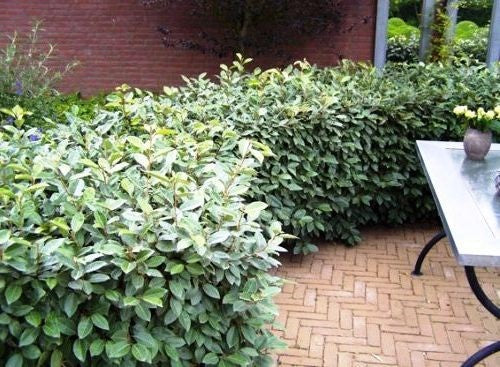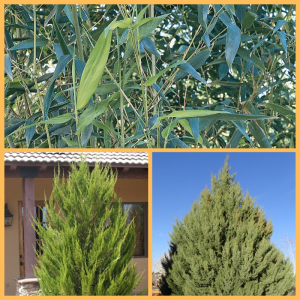By Ken Lain, the mountain gardener
June is an ideal time to plant a new living wall. With the building boom currently in full swing, privacy is a hot topic at the garden center. Without strategically placed evergreens in the yard it can feel as if prying eyes are looking right into your home. Not only does your privacy seemingly disappear, but that neighbor’s debris pile can be in full view!
The solution to both of these unwanted invasions of privacy is not rocket science. Simply plant a wall of living trees or shrubs to block an undesirable view and to create some privacy.

- For faster growth, plant large trees and long hedgerows.
- Silverberry, Euonymus, Cotoneaster are super-fast-growing hedges
- 3-steps to planting success, Mulch, 7-4-4 Food, Root & Grow
- Top performing trees for screens: Arizona Cypress, Austrian Pine, Bamboo, Colorado Spruce, Juniper, Pinyon Pine
- The Garden Center offers a Planting Service that includes the 3 steps above
The current spring weather is perfect for planting a new hedge for maximum growth this year. Pictured is a perfect example of an “evergreen” native hedge of Silverberry.

To successfully add evergreens to a landscape, there are three essential steps worth your time and energy. The most important requirement for evergreen trees to thrive is drainage. [1] To create proper drainage blend one shovelful of Watters Premium Mulch into every three shovels full of native earth to pack around each plant’s roots. [2] Feed new trees with “7-4-4 All Purpose Plant Food”. It is my formulation for local plantings. The cottonseed meal in this natural food promotes robust root formation while maintaining good foliage color. Lastly, [3] water your newly planted trees with a solution of ‘Root & Grow‘. It’s a water additive that encourages the roots of a plant to form a deep, healthy system.

Spartan Juniper
After two back surgeries, I am unwilling to do the actual planting of large trees anymore. Anything larger than a 15-gallon plant I will pay a crew to come out and plant trees for me. Our garden center offers a local planting service that includes all three steps above as well as incorporating the use of jackhammers and digging bars if necessary and hauling off the resultant debris. There is a warranty for the job.
When you’re ready to choose the trees for your living wall of green, read through the list that follows. It is comprised of screeners that over the years have performed well in local landscapes.
Arizona Cypress – MY favorite native evergreen screener is the Arizona Cypress. It is like a large alligator juniper in size and color, but grows faster and fills in more completely than other screening plants. Growing to over 20 feet high and 12 feet wide in just a few years, you can see why this is the number one choice for a planted screen.
Austrian Pine – A long-needled pine, much like a Ponderosa, but it holds its foliage all the way to ground level, and is less prone to bark beetle. Austrian Pines are well-known for their superior appearance. They have a fibrous root system and a cultured top which gives a nice, full appearance with no empty spaces. The dense, stout, pyramidal growth habit is topped with a uniform crown. Branches are in regular whorls, with dark green, stiff needles. Very hardy, it’s adaptable to winter cold and wind. It’s a tree of strong character that will serve well as either a landscape specimen or as part of a privacy screen.
Bissett Bamboo – One of the hardier bamboos! Used to soften corners of buildings, and as dense, tall screens on property lines or when adjacent to commercial land. Makes a beautiful background for water features and garden art, with a bonus of unlimited bamboo poles for staking other plants! Golden Groove Bamboo is another popular variety for local landscaping.
Colorado Spruce – Very cold-hardy, this spruce is the perfectly symmetrical Christmas Tree shape. Excellent choice for a front yard holiday tree or as a semi-formal accent in a large yard. It makes a pretty evergreen background for contrasting foliage colors, flowering shrubs, or to highlight autumn colors of deciduous trees and shrubs. Line up several to create a windbreak or to effectively diffuse lights and sounds along busy streets.
Juniper – An Arizona Cypress was too large for the Lain Casa yard, so we strategically used junipers because of their manageable size. Hillspire, Blue Point, Spartan, and Wichita are on the extensive list of junipers available now at the garden center. These new varieties have little-to-no pollen so are thankfully less prone to aggravate allergy sufferers. Whichever color and height you like, all grow well in this part of the world. Juniper forests surround us, so it’s a no-brainer that junipers are naturals to add to our landscapes.
Pinyon Pine – This dense pine is easy to care for and as cold hardy as any native can be. Its thick green needles are sturdy and more numerous than those of other pines, with less needle drop in summer. Thick and 25’ tall, it makes the perfect windbreak and an effective shield from prying eyes.
There are more screener choices, such as the larger evergreen shrubs and deciduous trees like aspens, but we’ll discuss those varieties another time.

Book just Published! The Secret Garden: Plants as a Natural Screen is a book wherein I’ve presented greater detail about screening plants for local gardens. Free copies are available for download at WattersGardenCenter.com under ‘LEARN’.
Until next issue, I’ll be here at Watters Garden Center helping local gardeners plan living screens for landscaped privacy.
Ken Lain can be found throughout the week at Watters Garden Center, 1815 W. Iron Springs Rd in Prescott, or contacted through his web site at WattersGardenCenter.com or FB.com/WattersGardenCenter .

